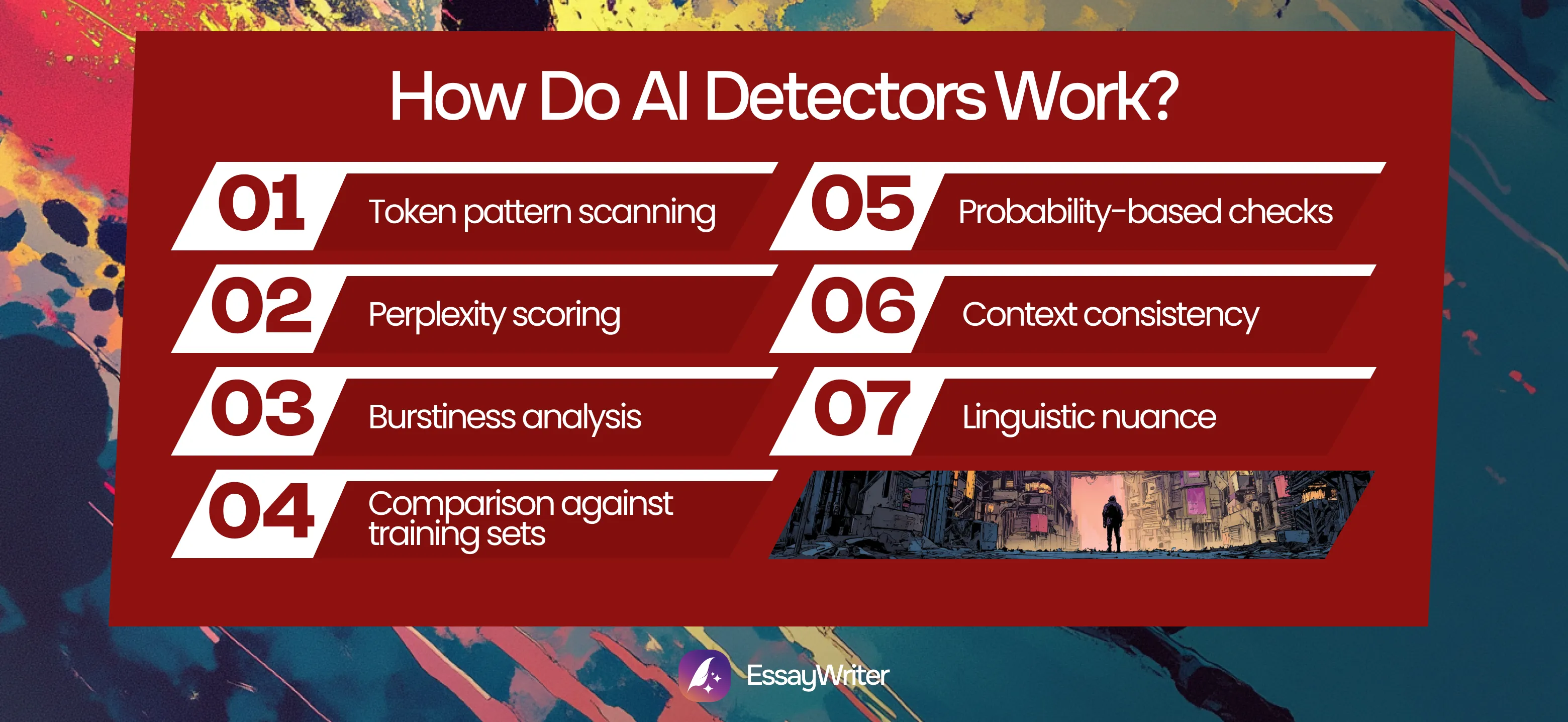You double-check every line of the essay you've just finished and still feel a pit in your stomach before hitting ‘submit.’ One scan from an AI detector, and your grade is only as good as the algorithm's guess. But what gives these tools that kind of power in the first place? Here’s what most AI detectors look at:
- How predictable your sentences are
- How much variety shows up
- How closely your writing matches known AI patterns
- How consistently ideas develop and transition
This article gets into the nuts and bolts of how do AI detectors actually work. And if you're short on time and need to quickly finish assignments, EssayWriter's free AI essay writer can help you catch up with your deadlines.
What Is AI Detection?
AI detection is the process of analyzing whether written text came from a human or a machine. It looks at flow and word predictability. If the sentence structure starts feeling too polished or overly predictable, the system leans toward an AI label.
It's not just a guess, either. AI detection tools are aggressively trained on both human and AI-generated writing, so they're excellent at recognizing patterns that keep showing up. That training helps decide whether the work came from a student or a tool trying to pass as one.
How Do AI Detectors Work?
There's no single method AI detectors use. We run into a mix of language models and statistical signals, not to mention the training comparisons, that help detectors reach a decision. Let's take a closer look:

- Token pattern scanning: AI-generated text often follows expected language patterns. Detectors scan sentence structures and flag overly clean phrasing.
- Perplexity scoring: This score reflects how easy it is to guess the next word in a sentence. AI detectors raise a red flag if the writing feels too easy to predict.
- Burstiness analysis: Human writing has rhythm. When writing feels too even, AI detection tools notice.
- Comparison against training sets: Most AI detectors compare your work to known examples of human and machine writing. If your style leans toward a machine-like rhythm, it shows.
- Probability-based checks: Some detectors run your text through an AI model to see how likely it is that each word would have been chosen by that system.
- Context consistency: AI often stays too consistent compared to human writing.
- Linguistic nuance: Some advanced detectors scan how naturally a thought transitions. Real writing has stumbles and a voice.
How AI Detectors Analyze Your Writing
AI detectors go through a few layers of analysis before they can label anything. AI detection includes measuring qualities of the text that most writers don't even notice. Below, we'll talk about a couple of most important methods AI detectors use to break your text down:
- Perplexity
- Burstiness
Perplexity
Perplexity is not a term we use every day, but it's one of the main methods AI detectors rely on. In simple terms, perplexity measures how predictable your writing is. Lower perplexity means your word choices are more expected. AI tools are trained to generate smooth sentences without much surprise, so they usually produce low-perplexity texts. Human writing, on the other hand, breaks rules and sometimes lands on less predictable phrasing. As a result, it usually has higher perplexity.
Simply put, low perplexity raises a red flag during AI detection. During a perplexity scan, the AI detector asks questions like:
- Would a language model already know this word is coming?
- Is this sentence too clean or too easy to follow?
- Does the writing feel like it came from a system that avoids risks?
Burstiness
Burstiness in AI detection measures the degree of variation in writing. Humans write with rhythm: some sentences are short, others are long... some change in tone or pacing. For example, when you're working on one of the college essay ideas, you might suddenly shift into reflection, then go back to the details of your personal story. Those up-and-downs are called burstiness and that kind of movement is very human.
AI writing, though? It lacks variation. AI-generated content stays in one lane with sentences of the same length and structure. So, if your text flows in an unbroken line, AI detectors will probably read it as a sign of machine-generated content. Burstiness is assessed by looking at:
- Sentence length variation
- Changes in vocabulary or tone
- Unexpected shifts in rhythm or pacing
Can You Really Trust AI Detectors?
AI detection is not always accurate because it is based on probability rather than certainty. There's a chance your text will be flagged as AI generated content even if you wrote it completely on your own. Here's what to remember:
- Human-written text can still be labeled AI, especially if it’s too polished or lacks personal detail.
- AI-generated writing edited or rewritten by a person might not get flagged at all.
- Results vary depending on which tool you use.
- Each system has its own formula and thresholds.
- Teachers and platforms often treat the results as final, even when they’re not.
What Limitations Do AI Detectors Have
AI detection tools are improving, but they’re far from perfect. Most of their limitations come from how language itself works. Human writing doesn’t always follow rules and neither do humans. Here’s where these tools fall short:
- They confuse formal writing with AI. Essays with clean grammar and sentence structure can raise red flags.
- They can’t understand meaning or intent.
- They over-rely on metrics that don’t always reflect who wrote the text.
- They struggle with creative pieces or anything highly personal.
- The same text can show different scores across platforms.
- They don’t handle multilingual or translated writing well.
- They can discourage good writing habits by penalizing clarity and flow.
- A high score doesn’t come with a breakdown of why.
Short On Time?
Use our free AI essay writing tool or get help from human professionals to turn in high-quality papers
Start Now
How Are AI Detectors Different from Plagiarism Checkers?
AI detectors and plagiarism checkers serve completely different purposes, although we can't deny that they're easy to confuse with each other. AI detection looks for originality in how the text was written, while the other checks whether the words were taken from somewhere else.
Where Do People Use AI Detectors?
Original work still matters. That's why the question 'is using AI plagiarism' is asked so often in academic circles. AI tools are now part of everyday writing, but so is the confusion around what counts as fair use. That's why AI detectors become a part of academic routines. Here’s how they’re commonly used:
- Teachers use them to check if students submitted work written by a tool or an AI tool.
- Admissions officers may scan college essays to spot inauthentic writing.
- Online platforms use them to catch AI-generated content that violates originality rules.
- Editors and publishers rely on them to make sure articles or submissions come from human authors.
How to Use AI Detectors the Right Way
AI detectors need to be used with care, however helpful they might be. After all, they give clues instead of concrete answers. Here are some smart ways to integrate AI detectors into your writing process:
- Always combine the tool’s result with human judgment.
- Don’t assume a high AI score means a student cheated.
- Make sure the tool you’re using is up-to-date and reliable.
- Avoid basing serious decisions on one score alone.
- Be transparent with students or writers if you're using AI detection tools.
- Encourage writing that sounds personal and specific.
- Know that even genuine work can get flagged
- Look closer before jumping to conclusions.
Final Thoughts
AI tools don't seem to be going anywhere, and neither are AI detectors. Understanding how they work will give you a better shot at avoiding unfair red flags. Let's recap a few important points from the article:
- AI detectors scan for patterns and predictability, not meaning or intent
- Tools rely on different methods to decide if something sounds like AI created content
- Human writing can still get flagged
- AI detection tools aren’t always consistent and don’t explain their results clearly
EssayWriter is an excellent resource if you need strong, original writing. Our tool can help you quickly create polished papers. And if you need real human help, our professional academic writers can always step in and offer expert essay assistance.
FAQ
How Do AI Checkers Work?
What Do AI Checkers Look For
Sources
- Is AI-Generated Content Actually Detectable? (2023, May 30). College of Computer, Mathematical, and Natural Sciences | University of Maryland. https://cmns.umd.edu/news-events/news/ai-generated-content-actually-detectable
- Kollmer, J. (2024, June 13). Detecting machine-written content in scientific articles. Uchicago.edu. https://biologicalsciences.uchicago.edu/news/detecting-ai-abstracts
Recommended articles



